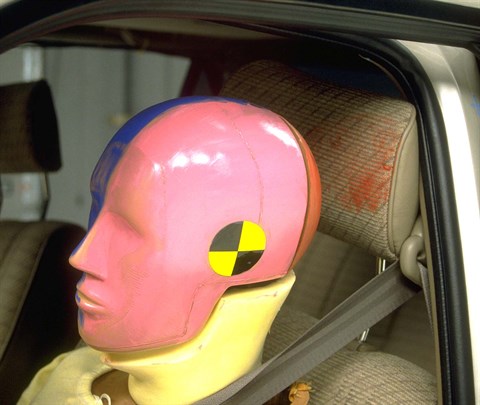Moderate overlap front: original test
Rating applies to 1996-2002 models
Tested vehicle: 1996 Toyota 4Runner SR5 4-door 4wd
The Toyota 4Runner was redesigned for the 1996 model year.
The Insurance Institute for Highway Safety has evaluated the crashworthiness of the 4Runner in a 40 mph frontal offset crash test into a deformable barrier.
Note: Airbag and safety belt changes beginning with 1998 and 1999 models improved the 4Runner's performance in the federal government's full-width crash test at 35 mph, which evaluates other important aspects of frontal crashworthiness. These changes are not expected to affect the results of the Institute's test, because measures indicate that significant injury to the upper body was unlikely in the tested 1996 model (these measures are most likely to be affected by airbag and safety belt changes).
| Overall evaluation | |
|---|---|
| Structure and safety cage | |
| Driver injury measures | |
| Head/neck | |
| Chest | |
| Leg/foot, left | |
| Leg/foot, right | |
| Driver restraints and dummy kinematics Dummy movement was reasonably well controlled. After the dummy moved forward into the airbag, it rebounded into the seat without its head coming close to any stiff structure that could cause injury. However, there was far too much upward movement of the steering wheel. |

Action shot taken during the frontal offset crash test.

The dummy's position in relation to the steering wheel and instrument panel after the crash test indicates the driver's upper survival space was maintained well, but there was more footwell intrusion than is desirable.

The dummy stayed in position throughout the crash. During rebound, its head hit only the head restraint.

The 4Runner's bumpers are very poor. They allowed excessive damage in low-speed impacts.
Measures of occupant compartment intrusion on driver side
| Test ID | CF96005 |
|---|---|
| Footwell intrusion | |
| Footrest (cm) | 17 |
| Left (cm) | 16 |
| Center (cm) | 20 |
| Right (cm) | 16 |
| Brake pedal (cm) | 14 |
| Instrument panel rearward movement | |
| Left (cm) | 3 |
| Right (cm) | 5 |
| Steering column movement | |
| Upward (cm) | 16 |
| Rearward (cm) | -1 |
| A-pillar rearward movement (cm) | 1 |
Driver injury measures
| Test ID | CF96005 |
|---|---|
| Head | |
| HIC-15 | 463 |
| Peak gs at hard contact | no contact |
| Neck | |
| Tension (kN) | 1.8 |
| Extension bending moment (Nm) | 23 |
| Maximum Nij | 0.33 |
| Chest maximum compression (mm) | 28 |
| Legs | |
| Femur force - left (kN) | 1.2 |
| Femur force - right (kN) | 1.0 |
| Knee displacement - left (mm) | 0 |
| Knee displacement - right (mm) | 0 |
| Maximum tibia index - left | 0.58 |
| Maximum tibia index - right | 0.84 |
| Tibia axial force - left (kN) | 3.3 |
| Tibia axial force - right (kN) | 4.1 |
| Foot acceleration (g) | |
| Left | 97 |
| Right | 141 |
